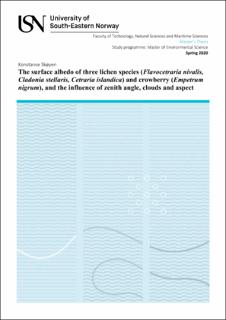| dc.description.abstract | The surface albedo of vegetated surfaces can influence the climate through the fraction of the solar radiation that is reflected back to the atmosphere. In this study, I have measured the surface albedo of three lichen species Flavocetraria nivalis, Cladonia stellaris, and Cetraria islandica, and crowberry, Empetrum nigrum, with increasing cover in idealized field experiments performed in Bø, South-Eastern Norway, in April to June 2019. In addition, the impact of environmental factors that affect the reflection of solar radiation was studied. These factors include the solar zenith angle, aspect and cloud cover for explaining the variation in the surface albedo.
The results show that the surface albedo differs between species of different colors. The surface albedo decreases respectively for the different surfaces of C. stellaris (0.36), F. nivalis (0.34), 25 % E. nigrum (0.29), 50 % E. nigrum (0.23), 75 % E. nigrum (0.18), 100 % E. nigrum (0.15) and C. islandica (0.15). The surface albedo can differ within and between growth forms, and the C. islandica has similar surface albedo as total coverage of E. nigrum. With decreasing coverage of C. stellaris and increasing coverage of E. nigrum, the reflection of solar radiation decreases.
The surface albedo is also influenced by environmental factors. Clouds can lower the incoming solar radiation and show most effect on the albedo. With increasing cloud cover the influence of zenith angle and aspect can be lowered, where less radiation reaches the ground. Under cloudless conditions a north-facing slope receives less radiation than a south-facing slope. With increased cloudiness there is a smaller difference between these slopes.
A change in the surface albedo can influence the energy budget at the ground. Vegetation in alpine areas are changing. As a response to climate change, shrubs are expanding at the expense of lichens distribution where warmer climate conditions are more favorable for shrubs. For more accurate projections for the future climate, the influence of species on the surface albedo is important to understand. | en_US |
